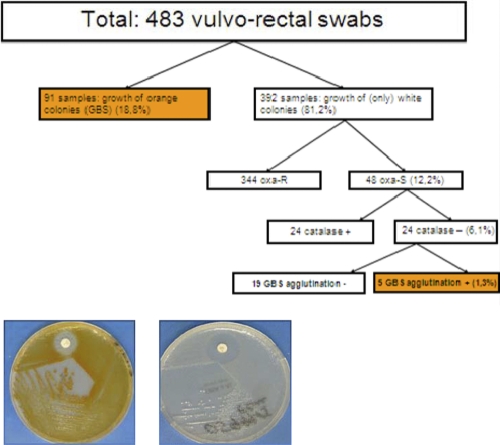LETTER
Group B Streptococcus (GBS) is an important cause of neonatal sepsis. Screening for maternal GBS colonization is generally advised at 35 to 37 weeks of gestation. For laboratory detection of GBS, one of the methods recommended by the CDC (2) is culturing of a vulvorectal swab on Granada medium after an enrichment procedure. Granada medium is a chromogenic plate which utilizes the unique ability of GBS to produce an orange carotenoid pigment (granadaene). Reading of Granada medium is easy and clear-cut. However, approximately 5 to 8% of all GBS strains do not produce granadaene, a characteristic closely linked to absence of hemolysis. These nonhemolytic GBS strains do not express the typical color change on Granada medium and thus are not picked up. In consideration of the severe potential consequences for the newborn when intrapartum antibiotic prophylaxis is withheld from pregnant women with GBS colonization, identification of these nonhemolytic strains is indispensable. As stated by the CDC (2), additional tests (blood agar plate, latex agglutination, new chromogenic media) are necessary to pick up nonhemolytic GBS strains. For this reason, we evaluated the addition of an oxacillin disk to Granada medium in an attempt to detect nonhemolytic GBS strains in an easy and cost-effective way.
(This research was partially presented at the 2011 ECCMID, Milan, Italy [1].)
In a prospective study, 483 vulvorectal swabs from pregnant women were tested for the presence of GBS by use of Lim Broth (BD) enrichment and Granada medium (bioMérieux). On arrival, the samples were directly plated on Granada medium with the addition of an oxacillin disk (1 μg; BD) in the primarily streaked quadrant; subsequently, all swabs were inoculated into Lim Broth. After overnight incubation, all Granada media were evaluated. In the case of absence of orange colonies, the Lim Broth enrichment was plated onto a second Granada medium with, once again, the addition of an oxacillin disk and another overnight incubation was performed. White colonies showing an oxacillin inhibition zone raised the possibility of the presence of nonhemolytic GBS and were tested for catalase. On the catalase-negative colonies, an agglutination test with group B antiserum (Strep Kit; DiaMondial) was performed. The work flow for GBS detection is shown in Table 1.
Table 1.
Work flow for GBS detectiona
| Time | Direct Granada plating | Lim broth + secondary Granada plating |
|---|---|---|
| Day 0 | Inoculation of vulvorectal swab onto Granada medium + addition of oxacillin disk | Vulvorectal swab placed in Lim Broth enrichment |
| Day 1 | First evaluation:
|
Enrichment inoculated onto second Granada plate + oxacillin disk (unless Granada already positive) |
| Day 2 | Second evaluation | Evaluation of secondary Granada plating (once):
|
oxa-S, oxacillin susceptible; oxa-R, oxacillin resistant.
After the second day, 91 samples (18.8%) showed typical orange colonies. Of the 392 plates with only white strains, 48 (12.2%) showed an oxacillin susceptibility zone. By means of catalase testing and subsequent agglutination with group B antiserum, 5 additional nonhemolytic GBS strains were detected. Thus, 5.2% (5/96) of the GBS strains detected were nonhemolytic and were picked up solely by means of the additional oxacillin disk. The results obtained in this study are shown in Fig. 1.
Fig 1.
Results of GBS detection.
Taking into account all costs of reagents and staff, the substantial increase in sensitivity obtained by using an oxacillin disk represents (in our setting) a supplementary cost of about $0.38/sample. This is definitely less expensive than supplemental blood agar plating or using new expensive chromogenic media.
To overcome the Granada medium's inability to detect nonhemolytic GBS strains, the addition of an oxacillin disk to Granada medium can provide a supplementary detection of approximately 5% of all GBS strains. This is an efficient and cost-effective method to intercept both hemolytic and nonhemolytic strains.
Footnotes
Published ahead of print 21 December 2011
REFERENCES
- 1. Nickmans S, Verhoye E, Boel A, Van Vaerenbergh K, De Beenhouwer H. 2010. Non-hemolytic GBS on Granada medium: there might be a solution for this problem, poster P982. 21st ECCMID, Milan, Italy [Google Scholar]
- 2. Verani JR, McGee L, Schrag SJ. 2010. Prevention of perinatal group B streptococcal disease—revised guidelines from CDC, 2010, MMWR Recomm. Rep. 59(RR-10):1–36 [PubMed] [Google Scholar]



